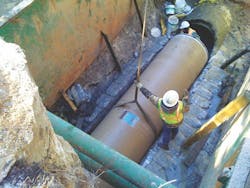About the author:
Erin Boudreaux is marketing assistant for Hobas Pipe USA. Boudreaux can be reached at [email protected] or 281.821.2200.
Conroe, Texas, is a growing suburban city 40 miles north of Houston with a population approaching 60,000 residents. Like most municipalities, the city of Conroe has maintenance tasks within its sewer and wastewater system that need to be addressed. One such project, the Interstate 45 Sanitary Sewer Rehabilitation, recently was completed.
As a budget-conscious city, Conroe designs and manages most of its own infrastructure improvement projects. The city believes this method increases its control while saving consulting expenses. The funds then are diverted directly toward ongoing maintenance projects as well as increasing the capacity within city water and sewer systems.
The I-45 Sanitary Sewer Rehabilitation project rehabilitated an existing 54-in. trunk line. The solution consisted of sliplining with 535 ft of 48-in.-diameter Hobas centrifugally cast fiberglass-reinforced polymer mortar (CCFRPM) pipe. As the main trunk line flowing into Conroe’s only wastewater treatment plant, this line is critical.
The project specifications allowed several different methods and products to rehabilitate the line, including a cured-in-place option and a segmental sliplining option. Trenchless methods were preferred due to the cover depth, which ranged from 20 to 22 ft, and the amount of surface traffic. The existing line ran underneath a heavily traveled interstate and popular rail line. Although both cured-in-place and CCFRPM pipe were specified, Lewis Contractors, Bertram, Texas, was the low bidder on the project and chose to rehabilitate the pipe by sliplining with CCFRPM.
Infrastructure Assessment
The existing 54-in. reinforced concrete pipe was installed in the late 1970s, so an inspection of the line was performed to determine the condition.
“They televised using ultrasonic technology,” said Erwin Burden, assistant public works director for the city of Conroe. Evaluation of the existing line by this technology can be used to verify defects in the existing line and provide information useful in determining the extent of corrosion on the line.
The survey revealed that the existing pipe was showing signs of deterioration. The steel reinforcement was visible in the crown of some of the existing concrete pipes.
“In addition to the decay, there was joint separation under the railroad crossing,” Burden said. Acting proactively, the city opted to rehabilitate the line.
Quick & Easy Installation
The entire project took approximately three weeks to complete, with the majority of the time spent preparing the job site for installation and post-installation cleanup. Hobas Pipe USA supplied 20-ft sections of 48-in.-diameter 36-psi-stiffness pipe. The pipe designed for this installation utilized a low-profile bell-and-spigot joint. This joint facilitates an easy, quick installation and requires less joining force. The entire 535 ft of pipe was installed in a 14-hour period.
The installation pit was placed on the east side of I-45, and the pipe string pushed west under the main lanes and feeder road of the interstate just south of Conroe’s Loop 336. I-45 is the city’s main interstate highway and a major traffic corridor that runs north-south across eastern Texas. Conroe is located on I-45 along the main traffic route between Houston and Dallas. In addition to traveling under roadways, the existing trunk sewer traveled within the Union Pacific Railway easement and, in one location, directly under the railroad crossing.
“The pipe was sliplined through an existing line that was in place, and there was no disturbance to the railroad right-of-way,” said Matt Lewis, project manager with Lewis Contractors.
The installation pit and work efforts were located adjacent to the rail line but did not affect its operation. Trains passed through daily, even during the installation of the slipline pipe.
The city obtained a permit from the Texas Department of Transportation to slipline the pipe under I-45.
“We were abandoning manholes along the frontage road so that we could move them out of the pavement, allowing us future access without having to shut down a lane and create traffic [jams],” Burden said. The high-strength fiberglass composite used for sliplining pipes is designed to withstand the E-80 and HS-20 live loads.
Bypass pumping was necessary during the installation due to the required manhole rehabilitation and relocation.
“The flow was too great, so we had to bypass pump, but still had a live flow within the line. It was just decreased, running about half,” Lewis said.
The pipe was installed from the upstream location downstream, with the flow.
“The new manholes that were installed were also manufactured of fiberglass material and were located at the launch pit and one receiving pit location. An additional manhole was installed on an existing 18-in. line, which redirected flow into one of the new manholes. There were two existing manholes that were plugged and filled with flowable fill and abandoned,” Lewis said.
The completion of this project will ensure that the line remains operational for the city of Conroe.
“The city has been proactive in upgrading our sewer system to corrosion-resistant materials,” Burden said.
ARTICLE SUMMARY
Challenge: The I-45 Sanitary Sewer Rehabilitation Project in Conroe, Texas, called for rehabilitating an existing 54-in. trunk line.
Solution: Trenchless methods were determined best, and the contractor decided to do the rehab by sliplining with centrifugally cast fiberglass-reinforced polymer mortar pipe.
Conclusion: The project took about three weeks to complete and served as an example of Conroe’s proactive approach to upgrading its sewer system.
Download: Here
